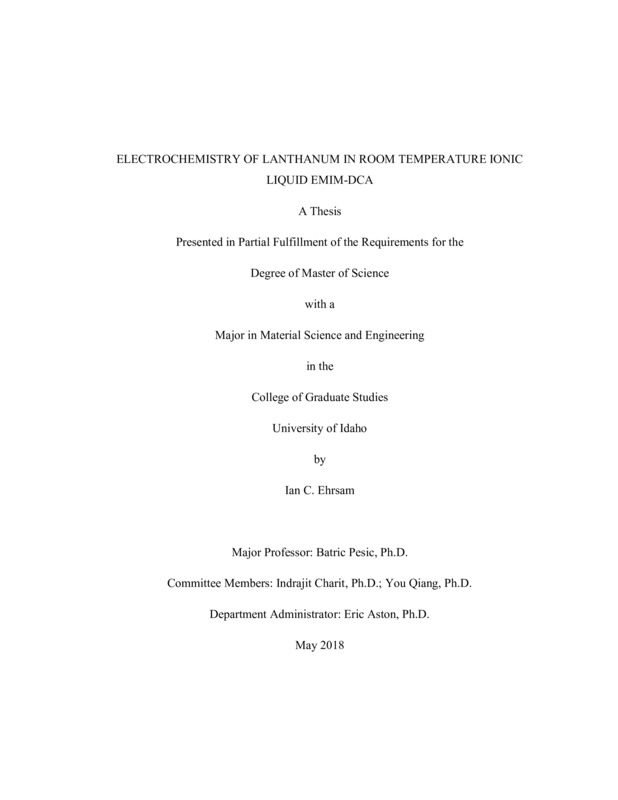ELECTROCHEMISTRY OF LANTHANUM IN ROOM TEMPERATURE IONIC LIQUID EMIM-DCA
Ehrsam, Ian. (2018-05). ELECTROCHEMISTRY OF LANTHANUM IN ROOM TEMPERATURE IONIC LIQUID EMIM-DCA. Theses and Dissertations Collection, University of Idaho Library Digital Collections. https://www.lib.uidaho.edu/digital/etd/items/ehrsam_idaho_0089n_11331.html
- Title:
- ELECTROCHEMISTRY OF LANTHANUM IN ROOM TEMPERATURE IONIC LIQUID EMIM-DCA
- Author:
- Ehrsam, Ian
- ORCID:
- 0000-0003-1234-8090
- Date:
- 2018-05
- Keywords:
- Electrochemistry EMIM-DCA Ionic Liquids Lanthanum Rare Earths
- Program:
- Materials Science
- Subject Category:
- Materials Science
- Abstract:
-
In nuclear engineering, the accumulation of lanthanides, as the main fission products, has detrimental effects on the efficiency of nuclear fuel because of strong neutron absorption properties. Therefore, the lanthanides need to be separated from actinides, a difficult task due to the similarity of chemical and electrochemical properties. One of the avenues for reprocessing nuclear fuels is electrometallurgy from ionic liquids. Ionic liquids can be classified according to temperature of application into (1) high temperature and (2) low temperature. High temperature ionic liquids are eutectic inorganic salts, such as LiCl-KCl. They are operational in the range 400 – 600 °C. Low temperature ionic liquids are made of an organic (cation) and inorganic (anion) components. They are fully ionized, stable, conductive and liquid in a much lower temperature range than ionic liquids based on inorganic salts, typically 25 - 100 °C. For that reason, they are often termed as room temperature ionic liquids (RTILs).
Due to lanthanide’s large electronegative deposition potential (~ -2.4 V vs SHE) traditional aqueous electrodeposition processes cannot be used as hydrogen evolution from water occurs prior to any lanthanide metal deposition. RTIL’s provide a unique solution to this problem as these salts are liquid at room temperature and provide a wide electrochemical window (up to 5 V) for deposition of electronegative metals without the detrimental effects from hydrogen ion reduction, as present in aqueous systems.
The goal of this study was to examine the electrochemistry and deposition morphology of lanthanum metal in the RTILs 1-ethyl-3- methylimidazolium dicyanamide (EMIM-DCA) and 1-butyl-3-methylimidazolium dicyanamide (BMIM-DCA) ionic liquids. These particular RTILs are stable in the cathodic direction up to -2.4V vs Ag/AgCl, providing the adequate stability to observe the electrodeposition of lanthanum metal.
Reduction mechanisms were characterized on the basics of cyclic voltammetry technique. For the determination of kinetic parameters, such as diffusion rate constant and reaction rate constant the rotating disk technique was employed. The effects of water and ethanol concentration were studied in details. The role of water was important to determine in order to evaluate its effect during its eventual absorption from open atmosphere. Ethanol gained in importance because of the solubility of rare earth salts in alcohols, as the only viable route toward solubilization of rare earths in ionic liquids. The diffusion coefficient of water in EMIM-DCA was calculated to be 7.6x10-7 cm2/sec. The reduction of water on platinum in EMIM-DCA exhibited sluggish kinetics and the rate constant was calculated to be 2.15x10-5 cm/sec. Both water and ethanol additions slightly reduced the stability window of the RTIL.
Morphology of lanthanum electrodeposits, observed around -2.0V, was characterized by using scanning electron microscope (SEM). Thin dense films were generally produced. However, the organic components of ionic liquids were also intermixed with metallic deposit, which were removed by washing with alcohol.
- Description:
- masters, M.S., Materials Science -- University of Idaho - College of Graduate Studies, 2018-05
- Major Professor:
- Pesic, Batric
- Committee:
- Charit, Indrajit; Qiang, You
- Defense Date:
- 2018-05
- Identifier:
- Ehrsam_idaho_0089N_11331
- Type:
- Text
- Format Original:
- Format:
- application/pdf
- Rights:
- In Copyright - Educational Use Permitted. For more information, please contact University of Idaho Library Special Collections and Archives Department at libspec@uidaho.edu.
- Standardized Rights:
- http://rightsstatements.org/vocab/InC-EDU/1.0/

